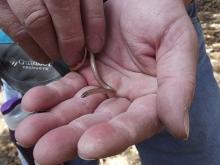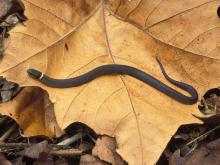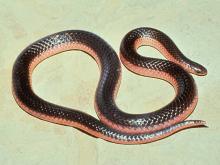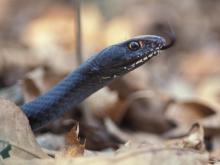Reptiles and Amphibians
Media

Species Types
Scientific Name
Storeria occipitomaculata
Description
The red-bellied snake is one of Missouri's smallest snakes. It is gray or reddish brown on top, usually with narrow stripes, and bright red or orange below. It occurs nearly statewide but appears to be absent from the northwest and southwest corners.
Media

Species Types
Scientific Name
Tantilla gracilis
Description
The flat-headed snake is Missouri's smallest snake. It is found in the southern half of the state except the far southeastern corner.
Media

Species Types
Scientific Name
Haldea striatula (formerly Virginia striatula)
Description
The rough earthsnake is a small, plain-looking snake of open, rocky woodlands in the Missouri Ozarks. It normally doesn’t exceed 10 inches in length.
Media

Species Types
Scientific Name
Diadophis punctatus arnyi
Description
Prairie ring-necked snakes are easily recognizable by their small size, uniform dark color on the back, bright yellow-orange belly, and distinct yellow ring around the neck. Secretive, but common nearly statewide.
Media

Species Types
Scientific Name
Carphophis vermis
Description
The western wormsnake is a small, two-toned snake that lives in wooded areas or rocky hillsides. It is usually purplish brown above and salmon pink on the belly and lower sides. It is found statewide, except for the Mississippi Lowlands.
Media
Species Types
Scientific Name
Ophisaurus attenuatus attenuatus
Description
The western slender glass lizard is often called “glass snake” because it is long, slender, and legless, and its tail breaks off easily. But glass lizards are true lizards, with eyelids and ear openings; snakes have neither of these characteristics.
Media

Species Types
Scientific Name
Coluber flagellum flagellum
Description
The eastern coachwhip is a long, slender, nonvenomous snake that usually escapes in an explosive burst of speed. In Missouri, it occurs in the Ozark and Ozark border regions.
Media

Species Types
Scientific Name
Phrynosoma cornutum
Description
The Texas horned lizard is rare in Missouri but once lived in several southwestern counties. Its name comes from the large, hornlike scales along the back of the head.
Media

Species Types
Scientific Name
Plestiodon obsoletus
Description
The Great Plains skink is a large, tan or light brown lizard with most of the scales edged in black, making it look speckled. These markings may form irregular lines along the back and sides. In Missouri, it's found only in our far western and southwestern counties.
Media

Species Types
Scientific Name
Scincella lateralis
Description
The little brown skink is a ground-dweller with dark brown or black stripes and speckling along the sides. Hiking in the woods, you may hear these small lizards scurrying through dead leaves, but you seldom see them. Occurs nearly statewide.
See Also
About Reptiles and Amphibians in Missouri
Missouri’s herptiles comprise 43 amphibians and 75 reptiles. Amphibians, including salamanders, toads, and frogs, are vertebrate animals that spend at least part of their life cycle in water. They usually have moist skin, lack scales or claws, and are ectothermal (cold-blooded), so they do not produce their own body heat the way birds and mammals do. Reptiles, including turtles, lizards, and snakes, are also vertebrates, and most are ectothermal, but unlike amphibians, reptiles have dry skin with scales, the ones with legs have claws, and they do not have to live part of their lives in water.





















